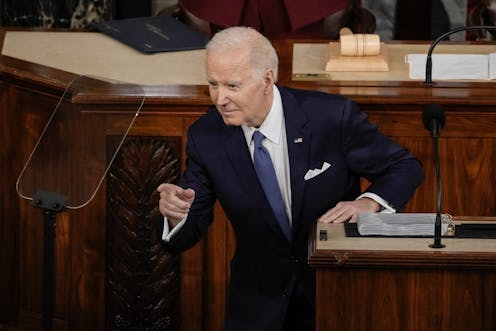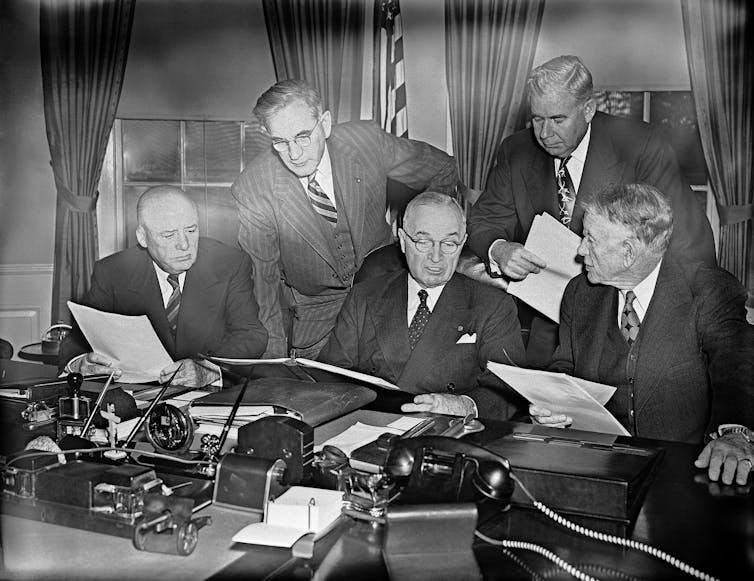
With a speech crammed full of promises – to provide more support to veterans, protect children from online dangers and crack down on fentanyl trafficking, to list just a few – President Joe Biden laid out his administration’s priorities in the annual State of the Union address.
For the most part, Biden struck a positive tone delivering the speech, which drew cheers and applause – and the occasional heckling – during the joint session of Congress. But the president’s upbeat demeanor came at the end of what is usually a tough and sometimes impossible process for the writers who have crafted the speech.
In any administration, writing the annual State of the Union address is a difficult assignment. I should know: I am a former presidential speechwriter for George H.W. Bush, and while I never wrote a State of the Union speech, I’ve seen the process up close and was always relieved to have dodged the bullet.
Sure, the State of the Union speech is one of the great rituals of our American democracy – but it’s also an unusually difficult and thankless job for any speechwriter.
The goal of a State of the Union address is to rally public support for the president’s domestic and foreign policy agenda.
This year’s speechwriters had to balance the president’s desire to point out his administration’s successes with voters’ negative sentiment about the way things are going. Among many others, NBC News polling found that large and persistent majorities of voters – over 70% in eight out of nine recent polls – continue to believe that America is on the wrong track. One NBC affiliate’s website claims the network’s polling has “never before recorded this level of sustained pessimism” among voters.
Similarly, Gallup found that the 22% of Americans who are satisfied with the way things are going in the U.S. represents one of the lowest levels the firm has ever seen. As public policy scholar Elaine Kamark wrote recently, the U.S. population is “wallowing in pessimism.”
Other presidential speechwriters have faced the same challenge. So, how does a speechwriter try to change opinions?

Matching agenda and voters’ concerns
The State of the Union speech is usually assigned to one speechwriter and one researcher, who start working on it weeks to months in advance.
The process typically begins with a call to all the Cabinet agencies asking for a paragraph or so from each on their accomplishments over the previous year and goals for the future. As the submissions come in, the speechwriter somehow has to string them all together in a compelling way.
At the same time, the challenge is to match the administration’s agenda with the voters’ top concerns. The latest Gallup poll shows that those responding to the poll believe government is the top problem facing the country, at 21%, followed by inflation at 15%, immigration at 11%, and the economy in general at 10%.
Yet The New York Times reports that Biden’s top economic aides argued for weeks over “how much to talk about child care, prekindergarten, paid leave, and other new spending proposals that the president failed to secure” in his first two years in office.
Those issues, which are important to the president’s agenda, are not exactly at the top of voters’ minds. How does a speechwriter balance the two?
Add to the assignment: the decision whether to lead with domestic or foreign policy; how to resolve differences on conflicting policies, goals or budget numbers among Cabinet agencies; and whether to craft clever applause lines that produce a standing ovation by the entire House and Senate, to show bipartisan support for the president in, say, targeting Big Tech. Or perhaps create lines aiming to spark roaring approval by one side of the aisle while the other sits on its hands, to make wedge issues clear to voters – such as increased spending proposals in the face of mounting national debt.
Representative guests
Along the way, the White House invites guests to hear the speech from the House gallery. This is a tradition that started during the Reagan administration, when Lenny Skutnik, a hero of the Air Florida flight that crashed into the Potomac, was recognized by the president and given a standing ovation.
Each guest is selected to illustrate specific policy areas in the speech. We saw this in President Biden’s recognition during his speech of the parents of 29-year-old Tyre Nichols, who was beaten by Memphis police and died three days later. “Let’s come together and finish the job on police reform,” Biden said.
It is the speechwriter’s job to highlight these stories in a way that puts a human face on public policy in a heartwarming, poignant and relevant way. The ancient Greeks called this “pathos” – and it’s often the most memorable part of the State of the Union address.
Once all this is ironed out, the final draft is circulated among the White House senior staff and the Cabinet for review.

The ‘final final’
It could take anywhere from hours to weeks to agree on the policy conflicts and budget numbers. The number of drafts can climb into the double digits. The Washington Post reported that this year, White House Deputy Chief of Staff Bruce Reed played a “key role” in smoothing out the policy sections.
At long last, the “final final” goes to the president for his edits. The usual rule is that no one can edit the speech after it goes to the president – no executive wants “a surprise on the way to the podium” in which the speech to be delivered is different from one that was approved.
Once the president is happy with the “final final” speech, rehearsals begin – often more than one – until the big night. Hours before the speech is given, the White House usually releases to the press an embargoed “as prepared” copy of the speech so that TV camera crews can cue the close-ups of people mentioned in the speech, and print and broadcast reporters can research the context and history behind the policies.
That evening, the House chamber is usually standing room only, with the primary audience being the members of the House, Senate, Supreme Court, military brass and invited guests. But the secondary audience is far bigger. The American people, as well as allies and enemies worldwide, are just as much the target of the president’s rhetoric as those in the room.
The television audience for the address has been shrinking over time. President Biden’s 2021 address drew the smallest number of viewers in the modern era, at 26.9 million. The numbers in 2022 were higher, but still lower than nearly all of Trump’s addresses. Roughly three times more Americans watch the Super Bowl than the State of the Union.
Many Americans simply wait for the highlights reel and the reactions of media commentators the next morning.
Here’s the problem: Most speechwriters are happy to dodge being assigned the speech, because no objective political analyst ever raved about the address – much less acknowledged how much work went into it. This year’s speech was no exception.
Editor’s note: A group of the author’s speechwriting students contributed to this article.
Mary Kate Cary does not work for, consult, own shares in or receive funding from any company or organization that would benefit from this article, and has disclosed no relevant affiliations beyond their academic appointment.
This article was originally published on The Conversation. Read the original article.



!["[T]he First and Fifth Amendments Require ICE to Provide Information About the Whereabouts of a Detained Person"](https://images.inkl.com/s3/publisher/cover/212/reason-cover.png?w=600)



